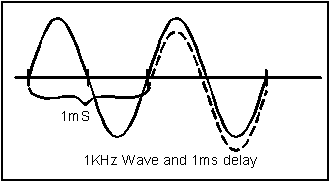

Copyright 1999 R.G.Keen. All rights reserved. No portion of these materials may be reproduced without written permission of the author.
The technology of phase shifters and flangers
Practically every guitarist has heard the swirling, spacey sounds characteristic of a phaser or its cousin, the flanger. These boxes have a unique sound that is immediately recognizable to us in rock and processed acoustic music. Unfortunately these effects are not the easiest effects to understand in terms of how that odd tone is made. The terms "phase shift" and "flange" are not part of our daily lives, and don't really convey up any mental image that's useful in understanding them.
What is phase shift?
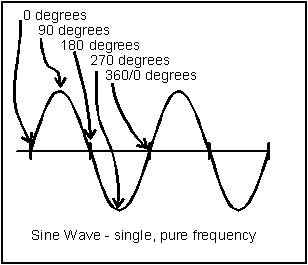
There is only a little electronics knowledge needed here. In the simplest case, a signal might be a pure sine wave. This sine wave alternates smoothly from positive to negative and back again. The places where the signal voltage is exactly 0Volts, neither positive or negative are taken by engineers to be the places where the sine wave starts. The "zero crossing point" where it starts positive is taken to be zero degrees, and the place where it starts negative is taken to be 180 degrees; when it gets back to the zero crossing where it starts positive again, it's been through 360 degrees, and is back at 0 degrees. The time it takes the wave to get back to 0/360 degrees is the period of the wave and is exactly one divided by the frequency of the wave.
If we have another sine wave that is the same size and frequency but has different zero crossing times, it is said to be shifted in phase relative to the first wave. If it starts positive a bit later than the first one, then it is lagging the wave we are using as a reference; if it starts positive a bit sooner than the reference, then it's said to be lagging. The amount it leads or lags is the relative phase shift of the second wave compared to the first one. A tiny time delay of any signal when added back to the original signal will cause it to lag the original signal by a bit.
If we have a situation where two waves of the same frequency, perhaps the same wave, but one image delayed a tiny bit of time, are added together somehow, they may reinforce one another or partially cancel one another. If they are exactly 180 degrees out of phase, they may totally cancel one another. If they start at close to the same time, they reinforce one another.
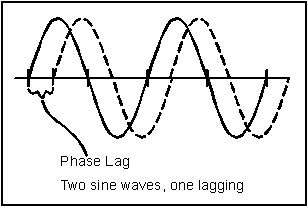
It turns out that the human ear is not too sensitive to phase shifts - that is, your ears can't really tell the difference between sounds that start by compressing your eardrum and ones that start by pulling out on your eardrums. What the ear is excruciatingly sensitive to is amplitude, or loudness, frequency, and the spectrum of harmonics of tones in a sound.
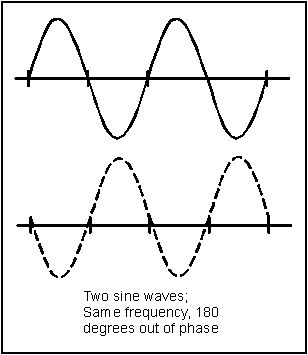
Take a little time...
When we take some complex sound with lots of harmonics across a whole range of frequencies and delay it a tiny bit, we have introduced some phase shift. If we have done this with a pure time shift, as with either an analog or digital delay, every component of the sound is delayed exactly the same amount of time. As an example, let's look at what happens if we use a 1millisecond delay. Remember the period of a wave is one divided by the frequency of the wave - that is, a 1KHz wave has a period of 1/1000 or 1 millisecond. Since this period is 360degrees of the wave, a 1ms delay of a 1KHz wave is a delay of exactly the period, so this delay is a phase shift of exactly 360 degrees, and the result is perfectly in phase with the original. However, a 500Hz wave has a period of 2ms, so the same time delay is only 180 degrees of delay to the 500 Hz wave, and it is exactly out of phase with the original - if we add the original to the delayed 500 Hz wave, they will cancel.
This same result happens for higher frequencies. A 2KHz wave has a period of 1/2ms, and so the delay of one millisecond is exactly two times the period of the wave, and the result is in phase with the original. A wave of frequency 1/(1.5ms) = 667Hz delayed by 1ms is delayed by one and one half waves, so the result is exactly out of phase with the original. In fact, every frequency that is an even multiple (x1, x2, x3, ...) of the time delay comes out perfectly in phase with the original. Every frequency that is an even multiple plus 1/2 of the time delay (0.5, 1.5, 2.5, 3.5, ...) will be exactly out of phase with the original. In between the even multiples (1, 2, 3, ...) and the even-plus-half multiples (0.5, 1.5, 2.5, 3.5, ...) the phase changes are intermediate, so they gradually fade from reinforcing to opposing. A constant time delay of a signal that is added back to the original will cause a whole slew of reinforcement peaks and cancellation notches across the whole audio spectrum. When displayed as a frequency response plot, there are lots of notches, giving the thing it's engineering name, a comb filter. The notches get more and more abundant as the frequency goes up. All by itself, this sounds very different from the straight signal, and is exactly what you get when you set an EH Electric Mistress to the "Filter Matrix" setting.


The results of a constant time delay on frequency response was known to engineers near the beginning of the 1900's, but how this actually sounded as an effect was discovered accidentally in the 1950's when Phil Spectre was producing a record and wanted to thicken up the vocals. He played back two copies of a vocal track at the same time and touched the flange of the tape reel to delay one a bit. The resulting sound was not just reverb-ed or thickened, it displayed the same comb-filter response, plus something a bit more exciting. Since the thumb on the flange of the tape reel was not perfectly constant, the delay varied a bit between the two signals. If you think about the description of time delays above, you'll see that the changing delay has the effect of moving the frequency notches up and down in frequency. This is NOT a subtle effect, and Phil was so enthralled with it that he went on to use it in most of his songs - the first "flanged" sound was "The Big Hurt." It was not the last.
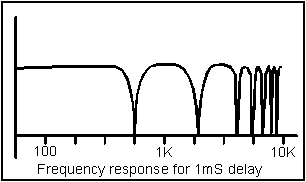

This is really all there is to a flanger - a time delay that can be modulated a bit, and a mixer to add the delayed signal back to the original or dry signal.
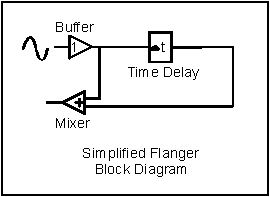
As a side effect, if you did not add the dry signal to the modulated-delay signal, you got what amounts to a frequency shift as the delay speeds up and slows down, so you have a true electronic vibrato.
Phase up to it...
Variable speed tape delays are a little clumsy to use on stage, so this effect only got used in studios at first. Then something else came up. Again, the engineers had known for a long time that inductors and capacitors cause phase shifts of signals through them Exactly who noticed this is not clear, but someone realized that the phase delay caused by an inductor or capacitor amounts to a small time delay in itself. If used properly, a capacitor/resistor or inductor/resistor network introduces a frequency dependent phase delay, no tape loops needed.
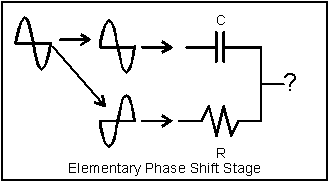
An elementary phase shift stage looks like this. A signal is converted to two signals, one a replica of the original, and one its mirror image (that is, 180 degrees out of phase at all frequencies). These two mirror image signals are fed into a capacitor and a resistor that are joined at the middle. The impedance of the capacitor goes down with increasing frequency, so at very high frequencies, the capacitor looks like a short circuit, and the signal fed to it dominates the result at the junction of the capacitor/resistor. As the frequencies of the signal get lower, the capacitor's impedance gets bigger. At very low frequencies, the capacitor has a higher impedance than the resistor, and the signal fed to the resistor dominates the signal at the junction of the two.
If the resistor got the non-inverted signal, and the capacitor the inverted one, then at low frequencies the resulting signal at the junction of the resistor and cap is just the non-inverted signal. At very high frequencies, the resulting signal is just the inverted signal through the cap. In the middle, the inverted and non-inverted signals add in a way that depends on the reactance of the capacitor versus the resistance. The math is a bit complicated, but it turns out that the result is always the same size (loudness) as the original signal, but its phase is different by a variable amount that depends on exactly what the frequency is. At the frequency where the capacitor's impedance is equal to the resistor, the phase shift is exactly 90 degrees, which is equal to a time delay of 1/4 of the period of that frequency. So we have a frequency dependent time delay, more shift at some places than others.
If we listen to the signal at the junction of the resistor and cap, we don't hear much of anything unusual, because the amplitude remains constant while the phase changes. Even if we add the original signal to the phase shifted signal, nothing much is noticeable except some increase or decrease of treble, depending on whether the capacitor got the inverted or non-inverted signal.
However, if we string up two of these things in series (using signal buffers so the two don't interfere), we find that the phase at that middle frequency has been shifted 90 degrees by the first phase shift stage and another 90 by the second one. The output of the second phase shift stage has a frequency where the total phase shift is 180 degrees. If we add it to the original signal, it cancels, just like the result for a pure time delay, but only at that one frequency. This IS a noticeable sound, and the MXR phase 45 works just like this - it has two phase delay stages, and only one notch.
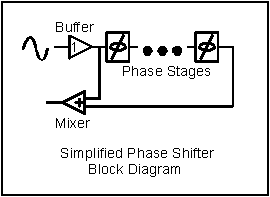
We can go on with this, stringing together more phase shift stages to get more notches. Each pair of stages adds one more notch. The most common commercial phase shifters stop with four stages (such as the MXR Phase 90, Univibe) or six stages (MXR phase 100). Note that the practicalities of the circuit require that any stage after the phase shift RC must not load the RC. It's best if the phase R-C is followed by a high impedance buffer.
This is very much like the time delay example in that although the effect is noticeable, it's much better if the notches move up and down in frequency. We can do that by taking note of the fact that changing either the resistor or the capacitor's value moves the frequency up and down. The simplest moving phase-notches setup would be to use four ganged variable resistors, and twiddle the knob. The cancellation notches would obligingly move in time to the twiddling; this gives us the now-familiar phasing sound.
More than one way to make a shift
The trick to getting phasing automated is to automate changing either the resistance or the capacitance; since capacitors are notoriously hard to modulate, every commercial phase shifter has come up with some scheme for varying a resistor in a phase shift stage - none vary the capacitor that I have seen. The following circuits show some of the ways.
- Univibe
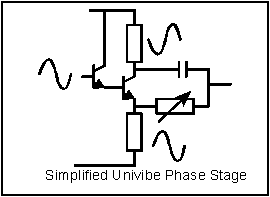
The Univibe, arguably the oldest phaser, also has the implementation closest to the elementary phase shift stage. The Univibe uses identical phase shift stages composed of a darlington connected pair of transistors, bootstrapped for high input impedance, and with equal collector and emitter load resistors for producing the two out-f phase signals needed for the next stage. The Univibe's method of modulating the phase resistor employs Light Dependent Resistors (LDR's) and a pulsating lamp to sweep the phase-induced notches up and down the frequency spectrum.
- Phase 45/90
There is a large group of phasers that use a variant of the elementary stage, taking advantage of the two inputs of modern opamps. In the elementary stage, note that if you did not invert the signal fed to the resistor, but rather subtracted the original signal from the capacitor, not adding it, that you'd get the same output signal. This is what the opamp implementation does. The RC is split into a C/variable R at the noninverting input, and the original signal fed to the inverting input. Varying the R at the positive input causes the phase change. There are a number of ways that have been used to change the resistance at the noninverting input. You can use LDR's, you can use the variation of the drain/source resistance of JFETS like the MXR, you can use the variable channel resistance of MOSFETs - practically any thing that acts like a variable resistor and doesn't distort too much can be used - even ganged pots!
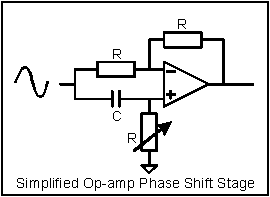
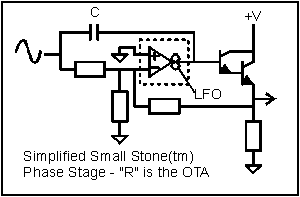
- Small Stone
A unique phase stage was cooked up by Electro Harmonix. Their "Small Stone" phase shifter used an "Operational Transconductance Amplifier" or OTA as the variable resistance in a phase stage, and an internal darlington buffer in one of the OTA IC's on the market as the buffer for the next stage. An OTA takes the difference of two input voltages, like an ordinary operational amplifier, but its output is not a voltage that is the sum of the two input voltages, but a *current* that is proportional to the difference between the two input voltages. The proportionality factor that tells you how many times the input voltage difference the output current becomes is controllable by the current into a "bias" pin. Looked at in one way, the OTA sources a current into its output node that depends on the amount of voltage at its input - kind of like a resistor does. Except in this case, the ratio of current out per voltage in is adjustable by that bias current (making it a variable resistor) and the proportionality may be either positive or negative, since it has both positive and negative inputs. In the case of the Small Stone, the OTA is used as a "negative" variable resistor, and the input signal is routed to the output through the phase capacitor. Since the OTA is a current source output, it sticks its current into the output node, ignoring the capacitor. The capacitor also contributes its current, so the two are added at the output node, and since the OTA also reversed the phase of the signal it processed, it looks like it came through an ordinary resistor that was connected to the mirror image of the input signal. This thing reduces to exactly the same circuit as our elementary phase stage, but the resistance can now be controlled by an electronic current. The same trick was later used by Maestro in their "Stage Phaser".
- Magnatone "Vibrato"
The last and perhaps most abstract phase shifter stage is the "Vibrato" in the old Magnatone amps. These things have a legendary sound in the vibrato setting, and they are only dimly understood. The only easily available variable resistors that the Magnatone resistors could get at the time these amps were designed were LDR's, which were very expensive then, and a newly available part called a "voltage variable resistor" or Varistor. Varistors had a resistance that was variable, depending on how much voltage was across them. The higher the voltage, the lower the resistance they showed to a signal. The Varistors of the '50's were not very sensitive, and it took 20-50V across them to make a difference in the resistance. Magnatone's designers had to somehow keep this large LFO drive signal from affecting the relatively tiny signals that the amp was processing.
What they did was to use a first triode as a phase splitter to give them the mirror image signals that a phase shift RC stage needs, and then feed this through two different paths. One path was through the usual phase capacitor to the next stage where the sensing of the mixed signals would be done. The second path was through the varistors and here it got complicated. The LFO itself was run through a phase splitter to generate a +LFO and a -LFO signal. The signal from the first stage was fed though a large DC blocking capacitor, and then to the junction of two varistors. The other ends of the two varistors were fed from a +LFO and a -LFO respectively. The sum of the + and - LFO appeared across the varistors, but this cancelled at the junction of the two varistors. The LFO ends of the varistors also fed DC (and LFO AC) blocking capacitors and joined the signal from the phase capacitor at the input to the next stage. Because the LFOs were out of phase, they tended to cancel at the input to the next stage as well, leaving only the signal, which had been through two variable resistors in parallel.
Magnatone used either one or two stages of this, depending on the amp, and never did the addition of the dry signal that would have made it into a true phase shifter. They settled for the electronic vibrato that it produced. This was the first true vibrato in an amp. Still, as complicated as it was for Magnatone to do it, it's still a variant of the simple R/C phase stage.
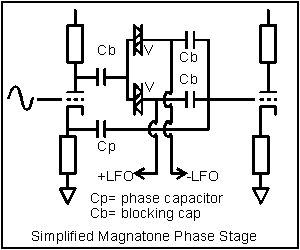
Feedback and "Resonance"
The human ear hears a frequency peak as a special case, a sort of instant recognition of an enclosed space. When the phase- or time-delayed signal is added to the original signal, the places where they cancel can be pretty dramatic, with perfect cancellation possible - that is, the notch removes almost all of the signal at that one frequency. However, when the delayed signal and the original reinforce, the result is just twice the size of either one - a "hump" only six db high. However, if you take a bit of the output signal from the phase or time delay line and route it back to the input to the delay line, the frequencies that reinforce are emphasized. In fact, you must ensure that you feed back a smaller version of the phase or time delayed signal than came into the input, or you will guarantee that the phase/time delay line will oscillate. Done judiciously, you can feed back enough to cause frequency peaks at the places where the signals reinforce, and keep the cancellation notches. This had a much more resonant and immediate sound. Different designers decide to feed back the signal from different phase stages sometimes; each stage has less phase difference, so there is s different set of peaks generated, and a different voice to each stage.
Phaser vs Flanger
Given that both these devices produce their tones by causing notches in the frequency response of the device and sweeping those notches up and down, which is best? And what else does something similar?
It turns out that anything that gives you a moveable notch will come off sounding like either a phaser or a flanger. There have been devices that used multiple voltage controlled notch filters of various technologies to simulate a phaser's notches. Everything that does notches works. Some of these are more elaborate than the phaser they emulate.
The real difference between a phaser and flanger is that a flanger always produces a large number of notches that are an even multiple of frequency apart. Even phasers with large numbers of stages (I've heard of 20 stage devices!) can't compete with the multiple notches that a flanger puts out. The spacing of the notches is also audible as a change in tone, and it takes some careful trimming to get phaser notches spaced the same regular spacing as a flanger.
To me, flangers sound smoother, and somewhat less contrived. On the other hand, phasers have their own "sweet spots". Which one is better? The real answer is - they're different, not competitors. Use the one YOU like where YOU like it.